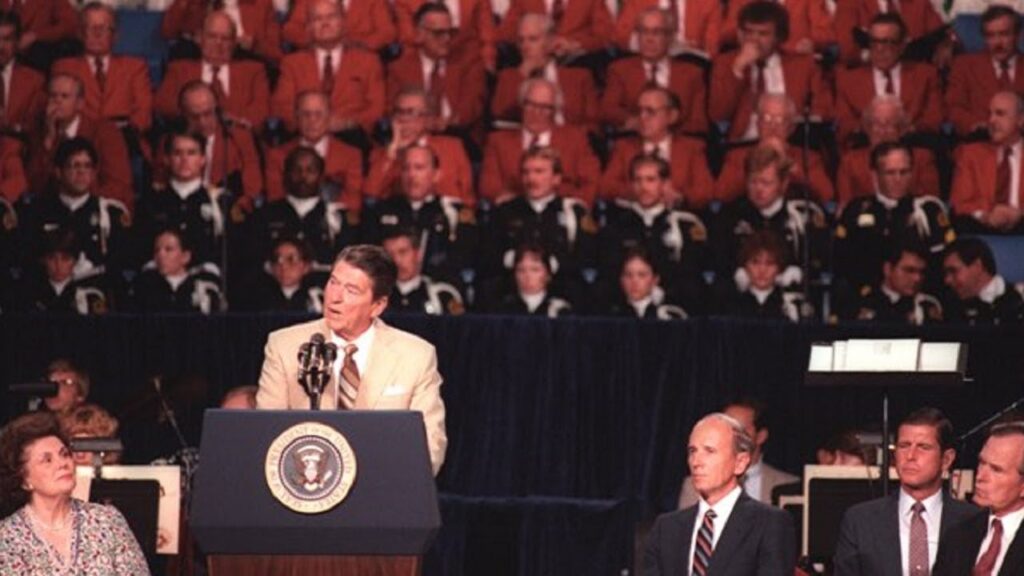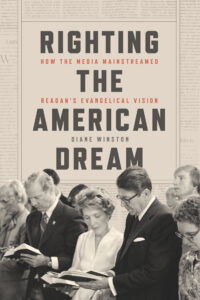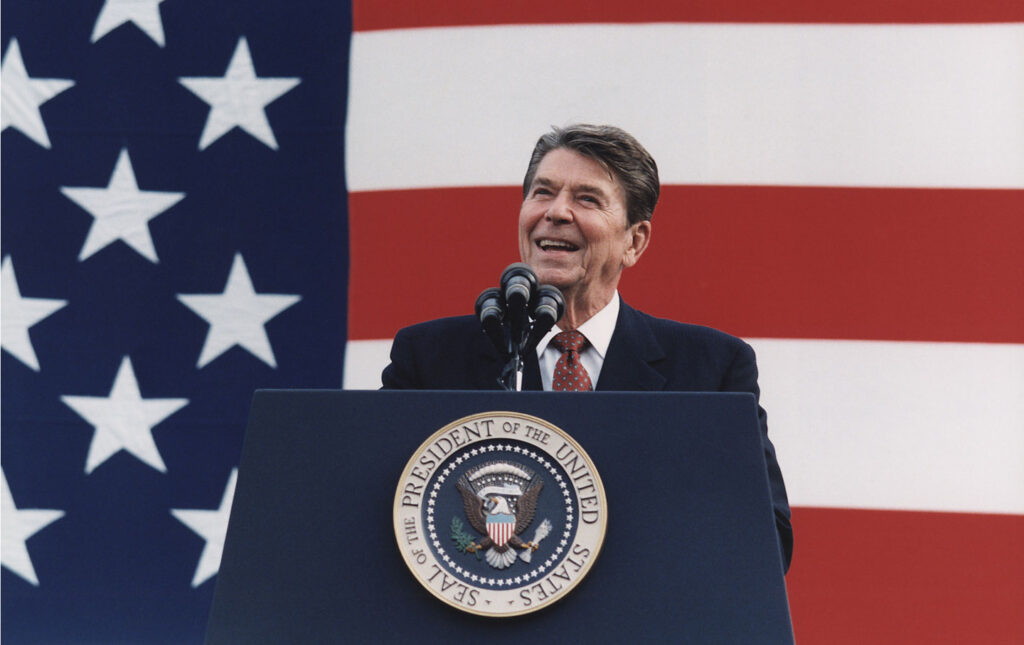Establishing Reagan’s Religious Outlook for the U.S.
An excerpt from “Righting the American Dream: How the Media Mainstreamed Reagan’s Evangelical Vision”

(President Reagan at a prayer breakfast in Dallas, Texas. Image source: American Rhetoric)
The following excerpt comes from the book Righting the American Dream: How the Media Mainstreamed Reagan’s Evangelical Vision” by Diane Winston (published by the University of Chicago Press © 2023 by The University of Chicago. All Rights Reserved). The book explores how the media normalized Reagan’s evangelical vision for the country.
This excerpt introduces readers to Reagan’s “religious imaginary,” his fusion of evangelical Christianity, neoliberal economics, and conservative politics.
***
A religious imaginary expresses a commonsensical, collective understanding of what matters and why. It accomplishes this by integrating metaphysical truths, ethical norms, and civic virtues into the core convictions and salient images defining a good citizen and a good society. In turn, these notions are expressed as a lived religion, the ways in which people enact ultimate concerns in their daily activities. These can range from preparing a Sabbath meal to confronting a cyberbully to participating in a Bible study group to voting. Daily activities both reflect and strengthen a religious imaginary; engaging in the activity reinforces the conviction, and the conviction gives meaning to the activity.
During the Reagan era, the specifics of the nation’s predominant religious imaginary shifted. Rooted in white Protestantism, the imaginary stipulates that America is special to God. Although other religious imaginaries reflect the theology and worldview of their faith groups’ relationship to the United States, the social, cultural, and political dominance of white Protestantism gives its imaginary preeminence. That’s why Catholics, Jews, Hindus, Buddhists, Muslims, and even nonbelievers can have their own religious worldview yet also accept the confluence of religion, politics, and economics that defines the white Protestant imaginary.
 Reagan did not set out to shift the religious imaginary; the very term likely would have puzzled him. But his core convictions, which contrasted with the principles that had guided the country since Franklin D. Roosevelt’s New Deal, resonated with many Americans. Reagan put their fears, hopes, and desires into words. Those words, circulated by the news media, became tangible, and their expression—in everyday life as well as in governmental policies—altered how many Americans understood their civic identity and personal responsibilities. Reviving the conservative vision of Barry Goldwater’s 1964 presidential campaign, Reagan called for less government and more individual accountability. Once elected, he converted these ideas into neoliberal policies. Ideologically, neoliberalism was a departure from the welfare liberalism espoused by Democrats since Roosevelt’s New Deal. Both ideologies support individual liberty and freedom, but the latter accepts restraints, such as regulations on business and a strong central government, to ensure the greatest good for the greatest number of citizens. Neoliberalism, in the name of maximizing individual freedom, advocates limited federal power and an unfettered marketplace, without concern for the greatest good for the greatest number of citizens. As a lived religion, or set of everyday practices for meaning making, neoliberalism is expressed through the logic and practices of the market. Under Reagan, these political and economic practices overlapped with expanding segments of American religion—specifically, conservative evangelicalism and the prosperity gospel. Decades before Reagan’s election, conservative Christian pastors and businessmen had asserted the connections among democracy, Christianity, and capitalism. Now the American president was singing the same tune while the news media circulated the lyrics.
Reagan did not set out to shift the religious imaginary; the very term likely would have puzzled him. But his core convictions, which contrasted with the principles that had guided the country since Franklin D. Roosevelt’s New Deal, resonated with many Americans. Reagan put their fears, hopes, and desires into words. Those words, circulated by the news media, became tangible, and their expression—in everyday life as well as in governmental policies—altered how many Americans understood their civic identity and personal responsibilities. Reviving the conservative vision of Barry Goldwater’s 1964 presidential campaign, Reagan called for less government and more individual accountability. Once elected, he converted these ideas into neoliberal policies. Ideologically, neoliberalism was a departure from the welfare liberalism espoused by Democrats since Roosevelt’s New Deal. Both ideologies support individual liberty and freedom, but the latter accepts restraints, such as regulations on business and a strong central government, to ensure the greatest good for the greatest number of citizens. Neoliberalism, in the name of maximizing individual freedom, advocates limited federal power and an unfettered marketplace, without concern for the greatest good for the greatest number of citizens. As a lived religion, or set of everyday practices for meaning making, neoliberalism is expressed through the logic and practices of the market. Under Reagan, these political and economic practices overlapped with expanding segments of American religion—specifically, conservative evangelicalism and the prosperity gospel. Decades before Reagan’s election, conservative Christian pastors and businessmen had asserted the connections among democracy, Christianity, and capitalism. Now the American president was singing the same tune while the news media circulated the lyrics.
The Reaganite religious imaginary rested on two convictions that were part of a conservative Protestant worldview: America is an exceptional country because it is God’s chosen nation, and God wants Americans to be free. The former validated America’s role as a world leader, and the latter confirmed the sanctity of the individual, made in God’s image, as a free agent. Over the centuries, successive generations shaped the divine covenant to reflect and to be reflected in the political and social currents of their day. Specifically, the Protestant religious imaginary has moved between poles of collective responsibility and of self-reliance. While the fundamentals of American identity remain the same—godly people doing God’s work in God’s country—public opinion and government policy mirrored changing perspectives on the philosophical and practical framework of a good and godly society. The Protestant imaginary, the shared framework for this virtuous society, has been communicated through news and entertainment media, textbooks and sermons, laws and legal rulings. It is embedded in daily life and manifested in everyday decisions ranging from hanging the flag on the Fourth of July, to promoting or opposing school prayer, to sending care packages to troops overseas.
Reagan and his supporters believed that America had lost its way: a bloated federal bureaucracy inhibited political freedom; an expanding welfare state choked the economy; government entitlements thwarted individual accountability; and secular humanism suppressed religion’s role in public life. Left unchecked, these trends would lead to communism, according to the Reaganites. In their view, a new paradigm was needed to secure Americans’ material freedom and to safeguard their spiritual wellbeing. Even as they acknowledged their country’s distinctiveness, Reaganites were less concerned with its citizens’ collective welfare than with the individual’s ability to live as freely as possible. This notion of self-reliance, based in equal parts on an Emersonian belief in the sanctity and integrity of the individual and on the Protestant conviction of “the priesthood of all believers,” lies at the heart of the Reagan-era religious imaginary. Its highest expression was the formation of virtuous citizen-consumers, each in God’s image, participating in a democracy that sustains free markets and unregulated capitalism. Reagan expressed this worldview in the idiom of evangelical Protestantism, but his emphasis on personal freedom and economic gain attracted Christians across the theological spectrum as well as members of other faiths and even nonbelievers.
The linkage of political, economic, and religious allegiances is a longstanding American trope. The Jacksonian era’s commitment to political democracy, individual salvation, and an imminent Kingdom of God, the Gilded Age’s fascination with Andrew Carnegie’s philanthropic beliefs out- lined in his essay “The Gospel of Wealth,” and the Progressives’ articulation of the Social Gospel all expressed Americans’ desire to align their civic project with a higher calling. In the 1970s, the vision inspired by the Social Gospel and enacted through the welfare state and plans for the Great Society succumbed to the Vietnam War, economic decline, political scandal, and social upheaval. But in the next decade, Reagan linked spiritual values to economic success, social stability, and military strength. In a religiously diverse yet secular society, the new formulation was both more and less explicitly Christian than earlier iterations. Reagan put evangelical particularism in service to universal goals, speaking directly to religious conservatives with a message that also held wide appeal. Evangelicals heard a message of faith-based politics, but non-evangelicals heard a candidate promise to “make America great.”
The success of Reagan’s Protestant imaginary depended on its spread through tabloids and magazines, and its reiteration on large screens and small. It was voiced in bingo halls and book clubs, in schoolrooms and boardrooms, and in churches and civic groups. Reagan spoke in an evangelical Christian register, but his message of free people living in an exceptional nation resonated with many Americans. The religious imaginary embraced core evangelical tenets, but it also spoke to men and women who cared more about money and markets than about school prayer or safeguarding traditional families. And as it penetrated newsrooms from the 1980s on, the imaginary became central to many of the stories that explained and organized everyday life.

(Image source: Everett Collection)
In the pre-digital era, reading the morning newspaper—or listening to a morning radio or television show—was a secular ritual. Repeated daily, it oriented news consumers to their world. By telling them what they needed to know, news outlets defined and structured a collective reality, creating “imagined communities”—masses of people who, though they might never meet, were nevertheless connected by shared narratives of what mattered and why.
Leaders seek to rally these imagined communities, and Reagan excelled at it. Once he had access to the mainstream press, his deeply felt assumptions about meaning, purpose, and identity—that is, his religious imaginary—were woven into the news. Tweaking public opinion by normalizing these narratives, the media played a role in the rise of the religious Right, the emergence of a “new” patriotism, and an ambivalent recognition that “greed is good,” the mantra of Gordon Gekko, the rapacious investor in the 1987 movie Wall Street. By helping set the nation’s vision and values, Reagan’s Protestant imaginary, relayed by the media, shaped the lived religion of the American people.
I have posited a Protestant religious imaginary that alternates between two poles. During the twentieth century, one of these gave rise to a Social Gospel–inflected welfare state, while the other culminated in a spiritualized neoliberalism. Just as the Social Gospel, a product of liberal Protestantism, had provided a religious frame for the New Deal and the subsequent rise of the welfare state, so conservative evangelicalism supplied a vocabulary and worldview for neoliberalism. During the Reagan era, conservative white evangelicals seized the cultural moment, obscuring the political moderation and social progressivism of other white and many Black coreligionists. As a result, evangelical became a synonym for white conservatives committed to having their religious beliefs dominate the public square and determine public policy. The story of why and how this happened hinges on the connections among the baby boomers’ spiritual seeking, a new kind of evangelicalism, the Reagan-era religious imaginary, the rise of evangelical mass media, and the mainstream news media.
Diane Winston is associate professor of journalism and Knight Chair in Media and Religion at the University of Southern California. She is the author or editor of several books, including Religion in Los Angeles: Religious Activism, Innovation, and Diversity in the Global City.
***
Interested more in this topic? Check out our conversation with Diane Winston in episode 37 of the Revealer Podcast: “Reagan’s Religious Vision for America and the Impact Today.”